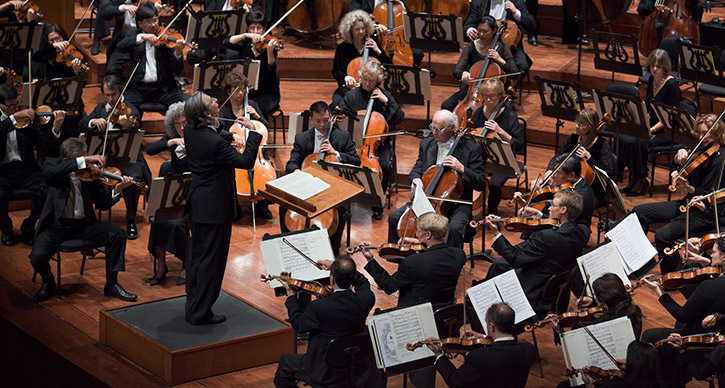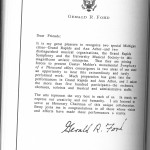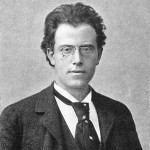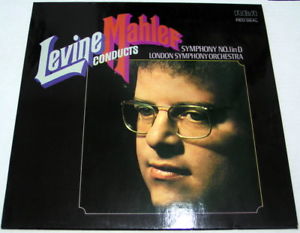UMS Playlist: Classical Music Old Friends from Communications Director Sara Billmann
This post is a part of a series of playlists curated by UMS staff, artists, and community. Check out more music here.

Photo: San Francisco Symphony, who’ll perform Mahler Symphony No. 7 at Hill Auditorium on November 13, 2014.
I grew up in a small town in Wisconsin and studied piano from age 5 and oboe from age 11 in a family where music was central. My mother was a piano teacher, taught vocal music in the public schools, and directed her church choir; my sister became a professional horn player and freelances in New York; and even my father, a middle school math teacher for over 35 years, participated by periodically singing in a local chorus and playing the baritone in a local German band.
Because of that background, I was constantly exposed to classical music, but there are some pieces that stand out as having made an incredible impression on me as a young musician from the time of middle school until early college. While my tastes have certainly evolved over the years, these are still my “old friends” that I love to revisit and never grow tired of.
Mahler’s Symphony No. 1: I fell in love with this piece in 7th or 8th grade and can remember being home alone, turning out all of the lights, and lighting candles to listen to an early James Levine recording in a complete solitude. Mahler could take me to a place of incredible peace, only to be interrupted by the bombastic beginning to the fourth movement, which always scared the bejeezus out of me. To this day, I’m still a pushover for Mahler and the emotional range that his symphonic and vocal works explore.
Bach Brandenburg Concerto No. 2: As an oboe player, I loved playing along with the record of Bach’s Brandenburg Concerto No. 2. It’s such a joyful piece, fun to play, but also fun to listen to. My sister would occasionally play along with me, adapting the trumpet part for horn.
Beethoven Symphony No. 9: I played this work in high school with my local orchestra (with my sister also in the orchestra and my dad in the chorus). Being immersed in the sound of full orchestra plus chorus all on one stage was a remarkable experience for a young musician.
Tchaikovsky’s Capriccio Italien: While seemingly not performed very often these days, this is one of the first classical music pieces that I can remember falling in love with, probably in about 5th or 6th grade. If I remember correctly, we had an LP that included Capriccio Italien, Marche Slave, and 1812 Overture, but it was always Capriccio Italien that I returned to time and again.
Dvorák’s “New World” Symphony: Dvorák’s works are readily accessible and easy to listen to, but certainly not “easy listening.” A recent New York Times article talked about how Dvorák ended up in Iowa, where he wrote this symphony.
Schubert: When I left Wisconsin to move to Ann Arbor to attend the University of Michigan, my sister (then a senior at the University of Wisconsin) made a couple of cassette tapes for me of some of her favorite pieces by Schubert, which I listened to constantly for several years. Among the highlights: Dietrich Fischer-Dieskau singing Die schöne Müllerin, the “Trout” Quintet and the Rondo in D Major for piano duo. Sadly, her tape ran out in the middle of the work, and it was years before I heard how it ended.
Shostakovich: Michael Gowing, the former UMS ticket office manager who retired over a decade ago, considered Shostakovich a “B movie composer,” but I always loved his works. While in college here at U-M, I heard Mariss Jansons conduct the Oslo Philharmonic in Shostakovich’s Symphony No. 7 with its Bolero-like theme, and it was an extraordinary event that began a lifelong appreciation for Shostakovich’s works. I still love listening to the string quartets (especially Nos. 7, 8, and 15), his piano quintet, and many of the symphonies. The Kirov Orchestra’s performance of his Symphony No. 13 several years ago left me in tears, completely shaken at the power of music.
Listen to various selections and recordings of Sara’s picks on Spotify:
What did you think about this playlist? Share your thoughts or song suggestions in the comments below.
This Day in UMS History: Mahler’s Symphony No. 8 (March 23, 1997)
Hill Auditorium
March 23, 1997
Mahler’s Symphony No. 8
Grand Rapids Symphony
Catherine Comet, conductor
UMS Choral Union
Grand Rapids Symphony Chorus
Grand Rapids Choir of Men and Boys
Boychoir of Ann Arbor
 Leafing through the 1997 program book for a March event, this concert struck me because of two things: a letter written by Gerald R. Ford and a picture of Gustav Mahler. Ford, who was the Honorary Chairman of this collaboration between UMS and the Grand Rapids Symphony, recognized with pleasure the cities of Grand Rapids and Ann Arbor, and the organizations that made this evening possible: the Grand Rapids Symphony and UMS.
Leafing through the 1997 program book for a March event, this concert struck me because of two things: a letter written by Gerald R. Ford and a picture of Gustav Mahler. Ford, who was the Honorary Chairman of this collaboration between UMS and the Grand Rapids Symphony, recognized with pleasure the cities of Grand Rapids and Ann Arbor, and the organizations that made this evening possible: the Grand Rapids Symphony and UMS.
Even as a professional musician, there’s a shocking amount of music and music history that I simply don’t know. I have performed five Mahler symphonies (1, 2, 3, 5, and 7), but have never heard Mahler 8, arguably his most famous. Shocking, perhaps, but also wonderful to know that music is a well that will never run dry. After spending four hours rehearsing Bartók’s Fourth Quartet yesterday, I listened to his Second Quartet for the first time ever today. So reading these program notes was an educational experience for me.
Mahler 8 combines two very different texts: the medieval Catholic hymn “Veni creator spiritus” (“Come, Holy Spirit”) and a scene from Goethe’s Faust (in German, of course). The program note says:
“[Mahler] saw no distinction between humanism and religion; in the Symphony No. 8 he sought to emphasize the link between the early Christian belief in the Holy Spirit which descended on the disciples like tongues of fire. Goethe’s Faust, on the other hand, tells of man’s ascent into a god-like state, transformed from mortality and led heavenward by the ‘Eternal-Feminine.’ Goethe altered the original version of the legend so that Faust is not damned for his sins, but is redeemed through the power of Gretchen’s love. Mahler explained, ‘the essence of it really is Goethe’s idea that all love is generative, creative, and that there is a physical and spiritual generation which is the emanation of this “Eros.”’ The kinship between Platonic love and the early Christian concept of God’s love – both of them able to create, edify, and redeem – unifies these two diverse texts into a single philosophical expression.”
The great conductor Leopold Stokowski, who conducted the US premiere (1916), compared the experience of hearing it for the first time with the impression Niagara Falls must have had on the first early explorers. Mahler said: “Try to describe the whole universe beginning to ring and resound. These are no longer human voices, but planets and suns revolving.”
The heartfelt nature of this piece is indicated in a final quote from the program note:
“Mahler’s wife, Alma, once remarked, ‘Gustav is always on the telephone to God,’ to which his biographer, Michael Kennedy, added, ‘In No. 8 he was on the hot line.”




